![]()
![]()
![]()
Use LEFT and RIGHT arrow keys to navigate between flashcards;
Use UP and DOWN arrow keys to flip the card;
H to show hint;
A reads text to speech;
49 Cards in this Set
- Front
- Back
|
Aboral vs oral side |
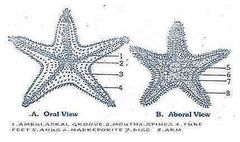
Aboral side up, tube feet on ground Oral side up, tube feet exposed upward |
|
|
What are Grantia spicules? |
Needles of calcium carbonate |
|
|
What is the purpose of Grantia spicules? |
They provide structural support and deter predators. |
|
|
Hydra classification |
Domain: Eukarya Kingdom: Animalia Phylum: Cnidaria Class: Hydrozoans |
|
|
Hydra body plan |
Radically symmetrical polyp |
|
|
Hydra mouth and tentacles |
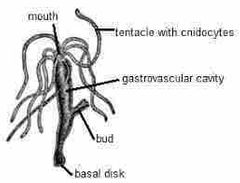
Back (Definition) |
|
|
Planarian classification |
Domain: Eukarya Kingdom: Animalia Phylum: Platyhelminthes Class: Turbellaria |
|
|
Planarian auricles And eyespots |
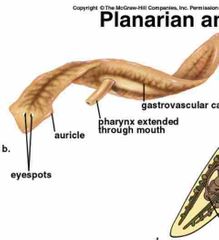
Back (Definition) |
|
|
Planarian mode of nutrition |
During feeding, a muscular, tubelike pharynx extends out from the mouth and sucks food |
|
|
Rotifer classification |
Domain: Eukarya Kingdom: Animalia Phylum: Rotifera |
|
|
Rotifer corona, foot, and toe |
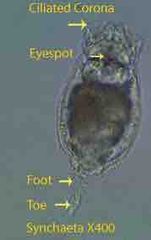
Back (Definition) |
|
|
Cnidarian classification |
Domain: Eukarya Kingdom: Animalia Phylum: Cnidaria |
|
|
Cnidarian body plan |
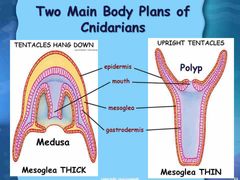
Back (Definition) |
|
|
Porifera sponge classification |
Phylum: Porifera |
|
|
Porifera osculum and ostia |
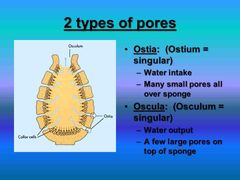
Back (Definition) |
|
|
Class Anthozoa |
Sea anemones, coral, and sea fans Solitary (anemones) or colonial (coral) polyps that lack a medusa stage |
|
|
Classification of all animals |
Domain: Eukarya Kingdom: Animalia Supergroup: Opisthokont |
|
|
Class Scyphozoa |
Marine jellies Mouth surrounded by tentacles Rhopalia (clusters of sensory cells on edge of “bell”) |
|
|
Phylum Cnetophore diversity |
Comb jellies 8 rows of comb-like plates of fused cilia Diploblastic Bilateral symmetry 2 tentacles covered with colloblasts |
|
|
Grantia xs |
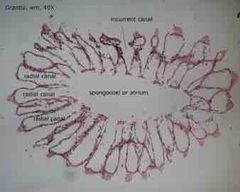
Back (Definition) |
|
|
Porifera body plan |
Outer epithelium: water comes in ostia and exits osculum Mesohyl: gelatinous matrix, spicules, spongin, amoebocytes Choanocytes: collar cells, flagellated to circulate water, engulf food from passing water |
|
|
Porifera diversity |
Sponges |
|
|
Cnidaria diversity and body plan |
Corals jellies hydras anemones Radial symmetry Diploblastic |
|
|
Class Hydrozoa |
Hydroids, hydra, Portuguese man of war Most have both polyp and Medusa stage (polyp often colonial: Portuguese man of war) |
|
|
Platyhelminthes diversity |
Flatworms dorsoventrally flattened Ciliated Acoelomate Parasitic or free living Incomplete digestive tract No circulatory system Excretory system Simple nervous system Sexual reproduction Hermaphroditic |
|
|
Platyhelminthes mode of nutrition |
Only one opening, pharynx Metabolic wastes usually excreted into gut, eliminated through mouth |
|
|
Platyhelminthes scolex |
Class cestoda: tapeworms Parasitic, adult attaches to wall of host intestine using scolex |
|
|
Phylum nematode diversity |
Roundworms Ecdysozoa/moult Parasitic or free living Pseudocoelomates Unsegmented Complete digestive tract No circulatory system Sexual reproduction |
|
|
Subphylum Chelicerata |
Sea spiders, horseshoe crabs, scorpions, spiders, and mites Body has 2 tagmata: cephalothorax and abdomen 6 pairs of appendages: Chelicerae- one pair as pincers or fangs. Pedipalps- one pair for sensing, feeding, or reproduction. Walking legs- 4 pairs |
|
|
Subphylum Crustacea |
Crabs, lobsters, crayfish, shrimps, barnacles, pillbugs 2 pairs of antennae 3 or more pairs of legs Appendages are biramous (branch in two) |
|
|
Subphylum Myriapoda |
Millipedes and centipedes Terrestrial Head with antennae and jaw-like mandibles Trunk with legs |
|
|
Subphylum Hexapoda |
Insects Live in most terrestrial and freshwater habitats 3 tagmata: head, thorax, abdomen Undergo metamorphosis: incomplete and complete |
|
|
Phylum Echinodermata diversity |
Sea stars, brittle stars, sea urchins, sand dollars, sea cucumbers Exclusively marine Coelomate Endoskeleton of calcium plates |
|
|
Class Asteroidea |
Sea stars and sea daisies Tube feet with suction cups Have 5 arms or multiples of 5 Can regenerate lost arms |
|
|
Class Echinoidea |
Sea urchins and sand dollars Lack arms Double rows of tube feet Protective moveable spines |
|
|
Phylum Mollusca |
Gastropods, bivalves, cephalopods |
|
|
Class gastropoda |
Internal fertilization Limpets, snails, slugs, nudibranch Head with pair of tentacles with eyes Coiled shell Radula Torsion: visceral mass rotates 180 degrees during development |
|
|
Class Cephalopoda |
Squid, octopus, nautilus Active predators Closed circulatory system Highly developed nervous system |
|
|
Class Bivalva |
Clams, scallops, mussels, oysters No radula or head Have two shells (valves) hinged together (adductor muscles counter hinge ligament) Suspension feeders Water enters through inhalant siphon and exits through exhalant siphon |
|
|
Class Polyplacophora |
Chitons Shell of 8 dorsal plates Grazing herbivores No head |
|
|
Phylum Annelida diversity |
Segmented worms Earthworms, leeches |
|
|
Class Polychaeta |
Clamworms, scaleworms, lugworms, sea mice, tubeworms Paired parapodia on segments |
|
|
Class Oligochaeta |
Earthworms, leeches Clitellum found in all members Few chaetae |
|
|
Phylum Anthropoda |
Most successful animals Segmented Jointed appendages Coelomate Segmentation, exoskeleton, jointed appendages |
|
|
Clam recognize anatomy: Gills, mantle, siphon, foot, adductor muscle, umbo, foot |
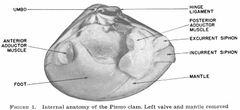
Back (Definition) |
|
|
Clam gill function |
Exchange gases and trap food |
|
|
Clam mantle function |
Secretes the shell and acts as a respiratory organ |
|
|
Clam siphon function |
Usually water enters the mantle cavity through the inhalant siphon, moves over the gills, and leaves through the exhalant siphon. |
|
|
Clam foot function |
Enables the clam to burrow itself in mud or sand |

